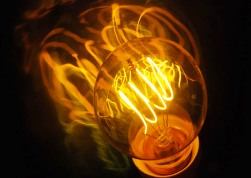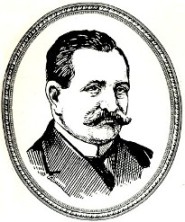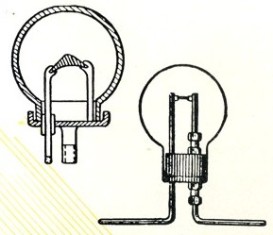Categories: Featured Articles » Interesting Facts
Number of views: 43588
Comments on the article: 3
Incandescent lamp A.N. Lodygina
 Everyone knows the usual incandescent lamp so long ago and has firmly entered our everyday life, which is perceived as something completely ordinary, taken for granted. But it was not always so. Only in the mid-19th century did the first working lamps begin to be created. Before widespread use was still very far away. Mass distribution of electric lighting systems became possible after Russian inventors created devices that could be used not only in laboratory conditions.
Everyone knows the usual incandescent lamp so long ago and has firmly entered our everyday life, which is perceived as something completely ordinary, taken for granted. But it was not always so. Only in the mid-19th century did the first working lamps begin to be created. Before widespread use was still very far away. Mass distribution of electric lighting systems became possible after Russian inventors created devices that could be used not only in laboratory conditions.
The origins of the study of the possibility of using electric lighting systems lie at the beginning of the XIX century. Back in 1802, our compatriot V.V. Petrov established that with the help of an electric arc "dark calm can be quite clearly illuminated."
Searches were conducted in different directions. Some inventors tried to solve the problem by applying directly the flame of an electric arc. Another part of the inventors was searching in a different direction: the glow of electric bodies with the help of electric current. There were also those who tried to cause the glow of rarefied gases by acting on them with electricity.
The incandescent lamps created by many inventors never went beyond the walls of laboratories. And there were a lot of them: 1845 - the Englishman King and the American Starr, 1846 - Gebel, 1849 - Petri and many others.
All these works did not find wide application until A.N. Lodygin did not create his incandescent lamp. A created by P.N. Bullseye electric lamp allowed to achieve success in the application of the electric arc.
 Alexander Nikolaevich Lodygin was born on October 6, 1847 in the Tambov province. He graduated from the Voronezh Cadet Corps and the Moscow Military School. He did not stay long as an officer, retired and took up invention. He was engaged in it all his life, right up to his death in the USA in March 1923.
Alexander Nikolaevich Lodygin was born on October 6, 1847 in the Tambov province. He graduated from the Voronezh Cadet Corps and the Moscow Military School. He did not stay long as an officer, retired and took up invention. He was engaged in it all his life, right up to his death in the USA in March 1923.
In 1873, the first public demonstrations of the first incandescent light bulbs suitable for practical use took place. Present at them N.V. Popov rightly remarked: “Lodygin - the first to make an incandescent lamp an instrument of technology. Lodygin - the first to take out an incandescent lamp from a physical office onto the street. "
The first incandescent lamps of Lodygin They were a glass spherical vessel inside which retort coal rod was reinforced on two copper rods with a diameter of 6 millimeters (coal obtained on the inner side of the retort walls by dry distillation of coal is notable for its significant hardness and good current conductivity) with a diameter of about 2 millimeters. Current was supplied through wires passing through a frame that covered the opening of the ball vessel.
Privileges for the invention of Lodygin were granted in France, Great Britain, Belgium, Spain and other countries. The first samples of Lodygin incandescent lamps had a very short service life, only about 40 minutes. Further improvements, such as redesign, have led to an increase in service life. V.F. Didrichson, one of Lodygin’s employees, suggested pumping air out of the lamps. But with the help of a simple hand pump, they could not provide the proper vacuum level in the lamp. Various carbonized organic substances, such as wood, plant fiber, have also been used. As a result of the improvements, the lamp life increased to 700-1000 hours. It was a real breakthrough.
In 1873, in St. Petersburg on Pesky, Lodygin made his first experience of street lighting with an electric incandescent lamp. In 1876, in the same St. Petersburg, on Morskaya Street, Florent's store was lit with incandescent lamps. In two months of operation, only two of the four coals burned out. It was a real success.
In 1874, the Academy of Sciences awarded Lodygin the Lomonosov Prize in the amount of one thousand rubles for the discovery, "promising to revolutionize the important issue of coverage."
Incandescent Lodygin
But as is often the case in Russia, Lodygin’s affairs were recognized as necessary, but he did not receive adequate financial support and the required number of assistants. Created by Lodygin, together with his friend and assistant V.F. Didrichson, the private company Russian Electric Lighting Partnership Lodygin & Co., soon went bankrupt. It would seem that the success of Lodygin’s invention promised the company further success. But the company preferred risky stock speculation to the further promotion and improvement of incandescent lamps.
The inventor did not have the necessary funds to deposit money for an American patent lost due to pennies. Having never received support, Lodygin was ultimately forced to emigrate to the United States.
Only six years after Lodygin, in October 1879, G.A. did the first experiment with an electric incandescent lamp. Edison, who was "the key to continued success." The Edison Electric Lighting Society was established with a capital of $ 300,000. The United States financial giants such as John Pierpont Morgan and others provided assistance to Edison.
The championship of the Russian inventor was then recognized by the world press. And when American entrepreneurs, advertising their invention, began to claim that an electric incandescent lamp was an American invention, they were rebuffed by the leading French world electrical magazine of the time.
In 1890 A.N. Lodygin received in the United States a patent for electric filament lamps with metal thread. By law, it was in the United States that the Russian inventor was given the primacy in the invention of incandescent lamps with metal thread from tungsten, osmium, iridium, palladium.
In 1906, Lodygin was forced to sell for pennies his patent for tungsten lamps to General Electric, which joined the company of Edison. Improving the invention of Lodygin, Edison began to produce incandescent lamps on an industrial scale.
As happened more than once in history, ingenious inventions often brought fame and income not to their inventors, but to their more enterprising colleagues. And although the industrial production of incandescent lamps was organized by Edison, it should be remembered that the primacy of the invention of incandescent lamps belongs to the Russian inventor A.N. Lodyginu.
See also on this topic:Who is the inventor of an incandescent bulb?
See also at e.imadeself.com
:

